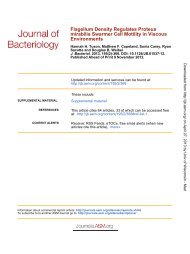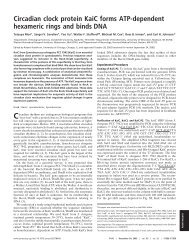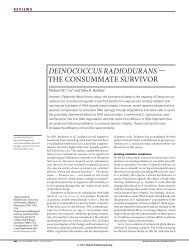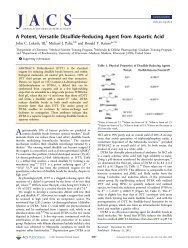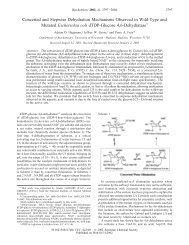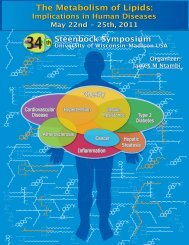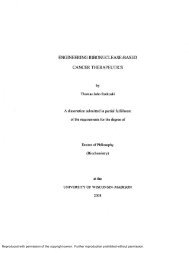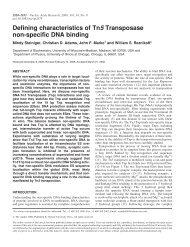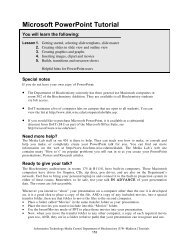The C. elegans Hand gene controls embryogenesis and early ...
The C. elegans Hand gene controls embryogenesis and early ...
The C. elegans Hand gene controls embryogenesis and early ...
You also want an ePaper? Increase the reach of your titles
YUMPU automatically turns print PDFs into web optimized ePapers that Google loves.
2882<br />
L. D. Mathies, S. T. Henderson <strong>and</strong> J. Kimble<br />
A 260 minutes<br />
ventral view<br />
B 320 minutes<br />
ventral view<br />
C L1 larva<br />
ventral view<br />
lateral view<br />
Z1 Z2 Z3 Z4<br />
DTC AC DTC<br />
For germline development, pie-1 <strong>and</strong> nos-2 control PGC fate <strong>and</strong><br />
influence their incorporation into the gonadal primordium<br />
(Seydoux et al., 1996; Subramaniam <strong>and</strong> Seydoux, 1999;<br />
Tenenhaus et al., 2001). In this paper, we report that the C.<br />
<strong>elegans</strong> <strong>H<strong>and</strong></strong> bHLH transcription factor hnd-1 is important for<br />
<strong>early</strong> gonado<strong>gene</strong>sis as well as for embryo<strong>gene</strong>sis. Specifically,<br />
hnd-1 influences the number <strong>and</strong> position of SGPs in the gonadal<br />
primordium, <strong>and</strong> affects body shape in the embryo. <strong>The</strong> hnd-1<br />
<strong>gene</strong> is expressed broadly in the embryonic mesoderm <strong>and</strong> then<br />
more specifically in the SGPs. Our results suggest that hnd-1<br />
governs maintenance of SGP fate <strong>and</strong> SGP survival. We also<br />
report the discovery of two <strong>gene</strong>tic enhancers of hnd-1, named<br />
ehn-1 <strong>and</strong> ehn-3 (for enhancer of <strong>H<strong>and</strong></strong>), that have overlapping<br />
functions with hnd-1 in embryo<strong>gene</strong>sis <strong>and</strong> gonado<strong>gene</strong>sis.<br />
MATERIALS AND METHODS<br />
dorsal<br />
ventral<br />
specification<br />
migration<br />
coalescence<br />
cell division control<br />
gon-2<br />
gon-4<br />
asymmetric division<br />
lin-17 wrm-1<br />
pop-1 lit-1<br />
sys-1<br />
Fig. 1. Early gonado<strong>gene</strong>sis in C. <strong>elegans</strong>. Somatic gonadal<br />
precursors (SGPs: Z1 <strong>and</strong> Z4), dark gray; primordial germ cells<br />
(PGCs: Z2 <strong>and</strong> Z3), light gray. (A) SGPs are specified within the<br />
mesodermal layer (white circles) <strong>and</strong> then migrate to meet PGCs.<br />
(B) SGPs <strong>and</strong> PGCs coalesce into the gonadal primordium, which at<br />
this stage has a left-right orientation. (C) During embryo<br />
morpho<strong>gene</strong>sis, the gonadal primordium shifts to an anteriorposterior<br />
orientation, <strong>and</strong> acquires left-right <strong>and</strong> dorsal ventral axes.<br />
<strong>The</strong> first SGP division is asymmetric <strong>and</strong> segregates the potential to<br />
make two regulatory cells: anchor cells (AC) <strong>and</strong> distal tip cells<br />
(DTC). Genes crucial for <strong>early</strong> SGP divisions are noted.<br />
Strains<br />
Animals were grown at 20°C unless otherwise noted. All strains were<br />
derivatives of Bristol strain N2 (Sulston <strong>and</strong> Horvitz, 1977). <strong>The</strong><br />
following mutations are described by Hodgkin (Hodgkin, 1997) or<br />
cited references. LGI: gon-2(q388) (Sun <strong>and</strong> Lambie, 1997) <strong>and</strong> sys-<br />
1(q544) (Miskowski et al., 2001). LGII: hlh-1(cc450) (Chen et al.,<br />
1994); unc-104(e1265); rol-6(e187); <strong>and</strong> mnDf93 (Sigurdson et al.,<br />
left<br />
right<br />
1984). LGIV: ced-2(e1752); ced-3(n717); gon-4(q519) (Friedman et<br />
al., 2000); unc-24(e138); unc-5(e53); dpy-13(e184); <strong>and</strong> nDf41. LGX:<br />
unc-9(e101). Dominant GFP balancers: mIn1[mIs14] for LGII<br />
(Edgley <strong>and</strong> Riddle, 2001); hT2[qIs48] for LGI; <strong>and</strong> nT1[qIs50] for<br />
LGIV. qIs48 <strong>and</strong> qIs50 are insertions of ccEx9747 onto hT2 <strong>and</strong> nT1,<br />
respectively. Molecular markers: qIs55 [hnd-1(N)::GFP]; qIs69 [hnd-<br />
1::GFPlacZ]; qIs56 [lag-2::GFP] (Siegfried <strong>and</strong> Kimble, 2002);<br />
leIs129 [pes-1::GFP] (Molin et al., 2000); qIs61 [pes-1::GFP]; ayIs7<br />
[hlh-8::GFP] (Harfe et al., 1998); <strong>and</strong> qIs77 [unc-122::GFP]<br />
(Miyabayashi et al., 1999). qIs56 <strong>and</strong> qIs61 were <strong>gene</strong>rated by<br />
microparticle bombardment (Praitis et al., 2001).<br />
Plasmids <strong>and</strong> trans<strong>gene</strong>s<br />
All cloning was performed by st<strong>and</strong>ard methods (Sambrook et al.,<br />
1989). PCR products were sequenced. Primer sequences are available<br />
upon request. Trans<strong>gene</strong>s were <strong>gene</strong>rated as simple arrays unless<br />
otherwise noted.<br />
hnd-1 cDNA (pJK849 <strong>and</strong> pJK901)<br />
Using a probe from the coding region of C44C10.8, we isolated a<br />
hnd-1 cDNA from an embryonic C. <strong>elegans</strong> cDNA library (a gift from<br />
P. Okkema) <strong>and</strong> subcloned it to make pJK849. <strong>The</strong> hnd-1 5′ end was<br />
cloned by RT-PCR using embryonic total RNA, a primer to the SL1<br />
trans-spliced leader <strong>and</strong> internal hnd-1-specific primers. A full-length<br />
hnd-1 cDNA (pJK901) was assembled from the SL1 RT-PCR product<br />
<strong>and</strong> pJK849.<br />
hnd-1(FL)::GFP (pJK850)<br />
GFP coding sequences were amplified by PCR from pPD95.81 (a gift<br />
from A. Fire) <strong>and</strong> subcloned into a hnd-1 genomic fragment (pJK906).<br />
pJK850 includes 1568 bp of the hnd-1 sequence upstream of the<br />
5′UTR <strong>and</strong> 182 bp downstream of the 3′UTR. pJK850 was injected<br />
with pRF4[Rol] (Mello et al., 1991) into hnd-1 to <strong>gene</strong>rate qEx486;<br />
this array rescued hnd-1 gonadal defects completely (n=136) <strong>and</strong><br />
reduced lethality from 28% to 7% (n=190).<br />
hnd-1(N)::GFP (pJK848)<br />
<strong>The</strong> first two exons <strong>and</strong> 1540 bp upstream of the hnd-1 5′UTR were<br />
PCR amplified <strong>and</strong> cloned into pPD95.81 (a gift from A. Fire).<br />
pJK848 was injected into unc-4(e120) with the co-injection marker<br />
pNC4-21[unc-4+] (Miller <strong>and</strong> Niemeyer, 1995) <strong>and</strong> N2 DNA to<br />
create qEx447 <strong>and</strong>, subsequently, qIs55. With the exception of SGPs,<br />
hnd-1(N)::GFP was detected in cells that also express hlh-1, a marker<br />
for body muscle (Krause et al., 1990).<br />
hnd-1::GFPlacZ (pJK900)<br />
<strong>The</strong> hnd-1 promoter (plus 11 N-terminal codons) was PCR amplified<br />
<strong>and</strong> cloned into pPD96.04 (a gift from A. Fire). pJK900 was injected<br />
with pRF4[Rol+] to create qEx492 <strong>and</strong>, subsequently, qIs69. pJK850<br />
<strong>and</strong> pJK900, but not pJK848, express GFP in several head cells that<br />
we have not identified.<br />
HS-hnd-1 (pJK902)<br />
<strong>The</strong> hnd-1 cDNA from pJK901 was cloned into pPD49.78 (a gift from<br />
A. Fire) to <strong>gene</strong>rate pJK902, which was injected into qIs61 with the<br />
co-injection marker pRF4[Rol+] to make qEx493. Embryos were<br />
subjected to two 30-minute heat pulses at 33°C, with a one hour<br />
recovery interval. Resulting L1 larvae were scored for extra SGPs<br />
using pes-1::GFP.<br />
hlh-1::hnd-1GFP (pJK904)<br />
A hnd-1::GFP fusion was <strong>gene</strong>rated by inserting GFP into the RsrII<br />
site of the full-length hnd-1 cDNA (pJK901). hnd-1::GFP was then<br />
cloned into pPD51.45 (Krause et al., 1990) to <strong>gene</strong>rate pJK904, which<br />
was injected into hnd-1 with the co-injection marker pRF4[Rol+] to<br />
make qEx496; this array rescued hnd-1 gonadal defects <strong>and</strong><br />
marginally rescued lethality (20%, n=372).



